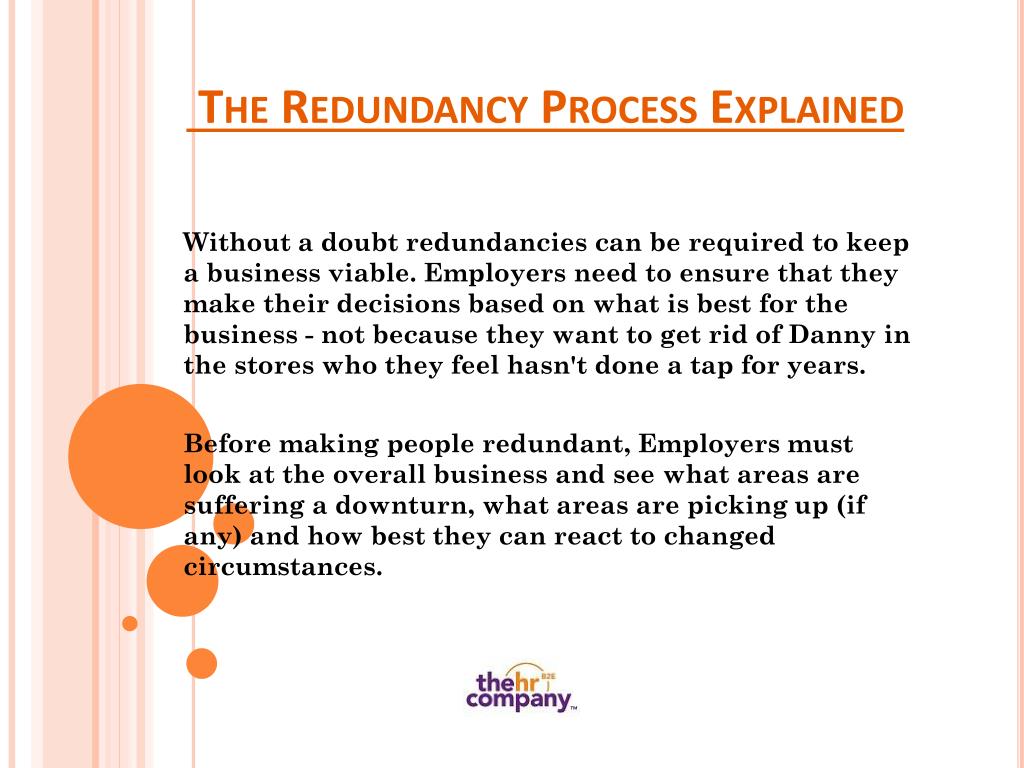If a Company Goes Bust Who Pays Redundancy? Lawful Insights for UK Worker
If a Company Goes Bust Who Pays Redundancy? Lawful Insights for UK Worker
Blog Article
Checking Out the Interplay In Between Company Redundancy and Business Adaptability for Future Development
In the dynamic landscape these days's business globe, the intricate partnership between firm redundancy and organizational flexibility emerges as a critical element for continual growth and success. Business frequently deal with the challenge of striking a delicate equilibrium between preserving a degree of redundancy to reduce threats and promoting adaptability to react promptly to the ever-evolving market needs. This delicate interplay holds the crucial to not only making it through in stormy times but likewise growing in the face of uncertainty. As we check out the complex dimensions of this interplay, appealing understandings right into how companies browse these complexities to lead the way for future growth await.
Significance of Company Redundancy
Business redundancy is a vital aspect that boosts business strength and mitigates operational risks. By incorporating redundancy steps within the organizational structure, firms can better withstand unpredicted interruptions and fluctuations in the company setting. Redundancy functions as a calculated buffer, allowing firms to adapt and respond efficiently to unanticipated challenges without endangering essential procedures.
One secret element of the importance of firm redundancy is its duty in guaranteeing continuity throughout times of dilemma. When confronted with abrupt modifications or emergencies, repetitive systems, resources, or personnel can action in to keep important functions and protect against extensive disruptions. This connection not only safeguards the firm's track record and client trust yet likewise minimizes monetary losses and operational downtime.

Methods for Business Versatility

One more critical approach is buying modern technology and infrastructure that can support flexibility and scalability. Implementing digital tools, automation, and information analytics can improve procedures, enhance efficiency, and give beneficial understandings for educated decision-making. In addition, developing versatile organizational structures that permit quick adjustments to market dynamics and consumer needs is necessary for remaining competitive in a rapidly evolving setting. By proactively determining prospective disruptions and chances, companies can proactively grow and adjust in an ever-changing service landscape.
Harmonizing Redundancy and Adaptability
Achieving an unified stability in between functional redundancy and business flexibility is critical in browsing the intricacies of a vibrant organization environment. Striking the best balance between redundancy and flexibility is a fragile procedure that requires a deep understanding of the organization's goals, sector dynamics, and threat resistance.
To achieve this equilibrium, business require to perform routine evaluations of their procedures to identify areas where redundancy is necessary for threat mitigation and where versatility can drive innovation and development. Applying adaptable go right here frameworks, promoting a society of constant understanding and improvement, and urging open communication across all levels of the company are essential strategies to harmonize redundancy and versatility successfully. By straightening these 2 vital aspects, companies can place themselves for sustainable growth and success in an ever-changing company landscape.
Situation Researches on Adaptation Success
In checking out instances of successful organizational adjustment, it becomes evident that the interaction between functional redundancy and versatility is a defining element in forming durable organizations. One engaging case research study is that of Netflix. At first a DVD rental solution, Netflix showed impressive versatility by transitioning right into a streaming system when digitalization disrupted the industry. By tactically buying innovation and web content production, Netflix not just made it through however flourished in a quickly developing market. One more standout example more is Amazon. Starting as an on-line book shop, Amazon continuously adapted its business version, increasing right into varied markets such as cloud computer and man-made intelligence. This versatility allowed Amazon to stay in advance of rivals and fulfill altering consumer demands. Last but not least, Adobe supplies a significant picture of effective adjustment. The firm shifted from offering software application licenses to a subscription-based version, guaranteeing recurring revenue streams and improved customer engagement. These study highlight the importance of operational redundancy coupled with business adaptability in fostering lasting growth and competition.
Building Strength for Future Development
Structure strength for future development needs a critical positioning of operational processes with market characteristics and arising patterns. Business should adapt to transforming settings by promoting a culture of flexibility, technology, and continual enhancement. Resilience entails not just getting better from setbacks yet additionally proactively getting ready for future challenges. One vital element of building strength is purchasing robust threat administration strategies to minimize prospective disruptions. This consists of scenario preparation, branching out supply chains, and developing backup prepare for different contingencies (who pays redundancy money).
Additionally, fostering solid relationships with stakeholders, such as consumers, staff members, suppliers, and the community, is important for preserving and weathering unpredictabilities count on and assistance during stormy times. Efficient communication and transparency play a crucial function in structure resilience, as they assist align expectations and assist in partnership in browsing unpredictabilities.
Additionally, organizations require to prioritize discovering and growth initiatives to upskill employees and furnish them with the needed devices to adjust to transforming circumstances. By purchasing their workforce, business can improve their flexibility and dexterity, inevitably strengthening their resilience for sustainable future growth.
Conclusion

In the dynamic landscape of today's company globe, the intricate connection in between company redundancy and organizational versatility arises as an important aspect for continual growth and success. Business usually deal with the obstacle of striking a delicate balance between keeping a level of redundancy to minimize threats and fostering flexibility to respond promptly to the ever-evolving market needs.To attain this balance, business need to perform normal evaluations of their procedures to recognize areas where redundancy is needed for threat reduction and where flexibility can drive development and growth.In conclusion, the interaction between firm redundancy and business flexibility is crucial for future growth. Building resilience through a combination of redundancy and who pays redundancy money adaptability will make certain that business are prepared for the challenges of the future.
Report this page